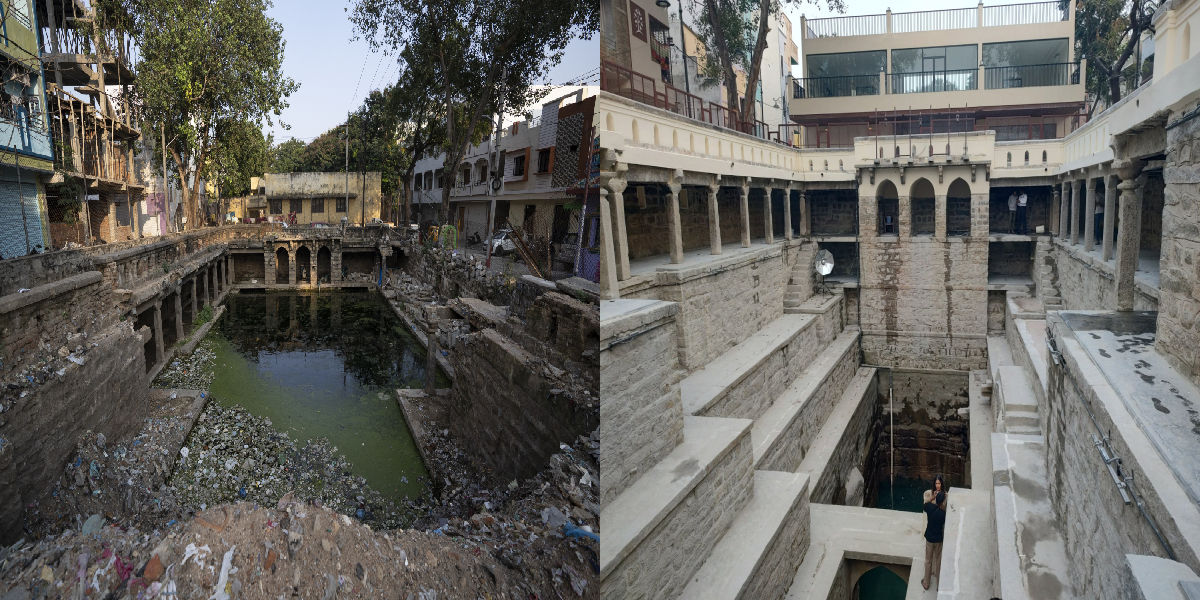The stepwell, restored over a period of one year with an estimated cost of ₹2 crore, was inaugurated by Telangana IT Minister KT Rama Rao.

The Bansilalpet stepwell in Hyderabad can hold 22 lakh litres of water and can help to stop urban flooding. (Supplied)
For 45-year-old Hajira aka Sheema, a resident of Bansilalpet in Hyderabad, the recently-restored 17th-century stepwell in her locality — inaugurated on Monday, 5 December, by Telangana IT & Urban Affairs Minister KT Rama Rao — brings back childhood memories.
“Around 30-35 years ago, the stepwell was used for several purposes. It was an open ground where kids used to play especially during holidays. Some used to swim as well,” she reminisced.
“People used to wash clothes, draw water from ropes and buckets, and celebrate festivals like Bathukamma, Bonalu, and Ramazan here,” she told South First, adding that the water was clean back then.
But soon the stepwell started turning into a place for garbage disposal.
“Due to a few suicides that took place, people got scared of coming here and started throwing garbage. But now, the glory days of the stepwell will again come with a new generation to witness them,” she recollected.
Hajira also pointed out that the maintenance of the stepwell now is equally important.
“I am sure that the community meetings have made the residents aware that now they have to take interest and stay on their toes to let this well not turn into a dumping yard again,” she said.
Kalpana Ramesh, the head of the Rainwater Project, which works on rainwater conservation and helped restore the stepwell, noted that the public-private partnership (PPP) behind the structure’s renovation was important.
“To put water back to the ground is our duty, and public participation is foremost, even for this stepwell,” she said.
“A lifeguard is also required, as is a gardener. A community needs to be built around it, and we have been working on it ever since we conceptualised the restoration.”
She added that communities and their behaviour have also been observed. “Maintenance has been our broad vision. This place will do well.”
The walls guarding the stepwell have also been fenced and barricaded.
“We will also install CCTV cameras here and a security agency will be given the charge to stop encroachments,” Secunderabad Zonal Commissioner Srinivas Reddy told South First.
The repairing work kicked off more than a year ago: in August 2021. It was done by the Hyderabad-based non-profit Rainwater Project and the Gandipet Welfare Society (GWS), in coordination with the Greater Hyderabad Municipal Corporation (GHMC).
As much as 2,000 tonnes of debris was removed to bring the Nizam-era stepwell back to life again.
“We have contributed ₹2 crore to the restoration of the well, while a small amount was given by the Telangana government,” GWS President Venugopal Vippulancha told South First.
“Some of our members even spent from their pockets. But we cannot do that every time as such projects need huge amounts. So we need the right people to come, especially corporate houses, and fund these projects,” he added.
About the GWS’ role, he said: “We coordinated with an architect from Bengaluru, and supervised the progress from time to time. We also asked government officials to give their feedback.”
The GWS also contributed to restoring the 300-year-old Asif Jah-period stepwell at Bapughat in Hyderabad.
Observing that these national heritages also help hugely in water harvesting, Venugopal added: “The whole nearby area gets plenty of underground water if such structures are conserved properly. It would prove to be beneficial for the future generations.”
Meanwhile, she noted that the labour force comprised 60-70 women and felt proud about it. “It was empowering for us as well as them as most of them never worked on any heritage structure,” she said.
An interpretation centre, a tourism plaza, an amphitheatre, and plans are afoot for a cafe in the area. “We want to turn it into a heritage and cultural space,” Kalpana said.

May 03, 2024

May 03, 2024

May 03, 2024

May 03, 2024

May 03, 2024

May 03, 2024